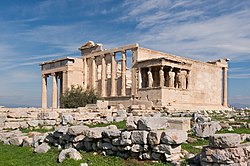
Back ارخثيون Arabic Erexteyon Azerbaijani Ерехтейон Bulgarian Erectèon Catalan Erechtheion Czech Erechtheion German Ερέχθειο Greek Ereĥteiono Esperanto Erecteón Spanish Erechtheion Estonian
This article possibly contains original research. (December 2023) |
| Erechtheum | |
|---|---|
Ἐρέχθειον (in Greek) | |
 | |
 | |
| General information | |
| Type |
|
| Architectural style | Ionic |
| Location | Athens, Greece |
| Current tenants | Museum |
| Construction started | 421 BC[1] |
| Completed | 406 BC;[1] (2430 years ago) |
| Owner | Greek government |
| Design and construction | |
| Architect(s) | May have been Mnesikles |
The Erechtheion[2] (/ɪˈrɛkθiən/, latinized as Erechtheum /ɪˈrɛkθiəm, ˌɛrɪkˈθiːəm/; Ancient Greek: Ἐρέχθειον, Greek: Ερέχθειο) or Temple of Athena Polias[3] is an ancient Greek Ionic temple on the north side of the Acropolis, Athens, which was primarily dedicated to the goddess Athena.
The Ionic building, made to house the statue of Athena Polias, has in modern scholarship been called the Erechtheion (the sanctuary of Erechtheus or Poseidon) in the belief that it encompassed two buildings mentioned by the Greek-Roman geographer Pausanias: the Temple of Athena Polias and the Erechtheion.[4] However, whether the Erechtheion referred to by Pausanias and other sources is indeed the Ionic temple or an entirely different building has become a point of contention in recent decades, with various scholars ruling out that Athena and Erechtheus were worshipped in a single building.[5] Alternative suggested locations of the true Erechtheion include the structures on the Acropolis conventionally identified as the Arrephorion, the Sanctuary of Zeus Polieus, the Sanctuary of Pandion, and the Dörpfeld foundations.[6] However, while there is no consensus among scholars on this issue, the building continues to be referred to as the Erechtheion by convention.
In the official decrees the Ionic building is referred to as "... το͂ νεὸ το͂ ἐμ πόλει ἐν ο͂ι τὸ ἀρχαῖον ἄγαλμα" (the temple on the Acropolis within which is the ancient statue).[7] In other instances it is referred to as the Temple of the Polias.[8] The joint cult of Athena and Poseidon-Erechtheus appears to have been established on the Acropolis at a very early period, and they were even worshipped in the same temple as may, according to the traditional view, be inferred from two passages in Homer and also from later Greek texts.[9] The extant building is the successor of several temples and buildings on the site. Its precise date of construction is unknown; it has traditionally been thought to have been built from c. 421–406 BC, but more recent scholarship favours a date in the 430s, when it could have been part of the programme of works instigated by Pericles.[10]
The Erechtheion is unique in the corpus of Greek temples in that its asymmetrical composition doesn't conform to the canon of Greek classical architecture. This is attributed either to the irregularity of the site[11] or to the evolving and complex nature of the cults which the building housed,[12] or it is conjectured to be the incomplete part of a larger symmetrical building.[13] Additionally, its post-classical history of change of use, damage, and spoliation has made it one of the more problematic sites in classical archaeology. The precise nature and location of the various religious and architectural elements within the building remain the subject of debate. The temple was nonetheless a seminal example of the classical Ionic style and was highly influential on later Hellenistic,[14] Roman,[15] and Greek Revival[16] architecture.
- ^ a b Langmead, Donald; Garnaut, Christine (1 December 2001). Encyclopedia of Architectural and Engineering Feats. ABC-CLIO. pp. 110–112. ISBN 978-1-57607-112-0. Retrieved 24 July 2012.
- ^ Travlos, 1971, p. 213
- ^ Ancient Greek: Ναὸς τῆς Ἀθηνᾶς τῆς Πολιάδος, Greek: Ναός της Αθηνάς Πολιάδος. An epithet it shares with the Old Temple of Athena.
- ^ Pausanias 1.26.5, Pseudo-Plutarch, Decem Oratorum Vitae 2.843e. LSJ s.v. Ἐρεχθεύς A.
- ^ See Kristian Jeppesen, Where Was the So-Called Erechtheion?, AJA, Vol. 83, No. 4 (Oct., 1979), pp. 381–394; Vinciane Pirenne-Delforge, "Un oikèma appelé Érechtheion (Pausanias, I, 26, 5)", in P. Carlier and C. Lerouge-Cohen (ed.), Paysage et religion en Grèce antique. Mélanges offerts à Madeleine Jost, Paris, 2010, pp. 147–163.
- ^ van Rookhuijzen, J.Z. (2021). "The Erechtheion on the Acropolis of Athens". Kernos. 34: 69–121.
- ^ IG I3 474.1 https://www.atticinscriptions.com/inscription/IGI3/474
- ^ Pausanias 1.27.1, Strabo IX 396
- ^ Iliad VII 80–81, Ody II 546–551
- ^ Not mentioned in Plutarch's list and the conventional date of the start of construction is after Perikles' death, however J.M Hurwitt, The Acropolis in the Age of Pericles 2004, p. 174 conjectures that the inception of the building dates to the 430s.
- ^ W. B. Dinsmoor, The Architecture of Ancient Greece, London. 1950
- ^ M. Korres "Recent Discoveries on the Acropolis," Acropolis Restoration: the CCAM Interventions, R. Economakis, ed., London and New York, pp. 175–179. 1994.
- ^ W. Dörpfeld, H. Schleif, Erechtheion, Berlin, 1942. See also Dinsmoor 1932, pp. 314–326, Elderkin 1912, pp. 53–58; Hawes, The Riddle of the Erechtheum.
- ^ Notably; Apollo Patroos
- ^ Temple of Roma and Augustus, Hadrian's villa Tivoli
- ^ Wilkins's Downing College, Inwood's St Pancras. Frank Salmon, The Erechtheion: An Overlooked Paradigm of the Greek Revival?, Cambridge, 2021, Accessed 17/10/2021
© MMXXIII Rich X Search. We shall prevail. All rights reserved. Rich X Search